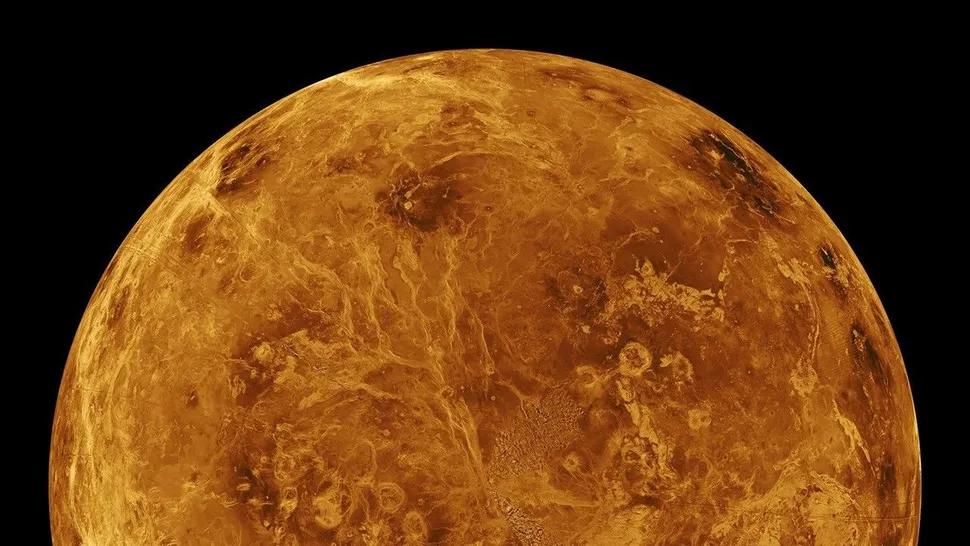Venus’ Surprisingly Thin Crust May Unlock Secrets of Its Intense Geological Activity

Venus' crust likely maxes out at about 40 miles (65 kilometers) thick — and in many places, it may be much thinner, a new study suggests. (Image credit: NASA/JPL-Caltech)
Pasadena, California – May 15, 2025
A groundbreaking study has revealed that Venus, Earth’s closest planetary neighbor, has a crust far thinner than previously thought, potentially explaining its intense geological activity. Published in Nature Geoscience this week, the research, led by scientists at NASA’s Jet Propulsion Laboratory (JPL) and the California Institute of Technology, suggests that Venus’ crust is only about 10 to 15 kilometers (6 to 9 miles) thick in some regions—half the thickness of Earth’s continental crust. This finding could shed light on why Venus is riddled with volcanic features and tectonic activity despite lacking Earth-like plate tectonics.
The discovery stems from data collected by NASA’s Magellan spacecraft, which mapped Venus’ surface with radar from 1990 to 1994, combined with new modeling techniques. Researchers analyzed gravity anomalies and surface topography to estimate crustal thickness, revealing a thinner, more dynamic crust than the 20 to 30 kilometers (12 to 18 miles) previously assumed. “A thin crust means the mantle is closer to the surface, driving heat and magma upward more easily,” said lead author Dr. Suzanne Smrekar of JPL. “This could explain Venus’ abundant volcanoes and constant resurfacing.”
Venus boasts over 80,000 volcanic features, including massive shield volcanoes like Maat Mons, and vast lava plains covering 80% of its surface. Unlike Earth, Venus lacks a global system of moving tectonic plates, yet it exhibits signs of localized tectonic deformation, such as rift zones and tesserae—cr crumpled, highland terrains. The thin crust may allow the planet’s scorching mantle, with temperatures exceeding 4,000°F (2,200°C), to fuel frequent eruptions and reshape the surface. “It’s like Venus is in a constant state of geological upheaval,” Smrekar noted.
The findings have sparked excitement on X, where space enthusiasts speculate about Venus’ past. “If the crust is this thin, could Venus have been more Earth-like billions of years ago?” one user posted. The study suggests that a thin crust could have facilitated rapid heat loss early in Venus’ history, potentially supporting liquid water before a runaway greenhouse effect turned it into the hellish world we see today.
However, the thin crust raises new questions. Why does Venus lack plate tectonics despite its dynamic geology? Co-author Dr. Paul Byrne of Washington University in St. Louis suggests the answer lies in the planet’s extreme surface conditions—900°F (475°C) temperatures and crushing pressures 90 times Earth’s. “The crust might be too hot and weak to form rigid plates, leading to a ‘squishy’ style of tectonics,” Byrne said.
The study aligns with renewed interest in Venus exploration. NASA’s upcoming VERITAS and DAVINCI missions, set to launch in the late 2020s, will map the surface and probe the atmosphere, potentially confirming the thin-crust hypothesis. Europe’s EnVision orbiter and India’s Shukrayaan-1, also planned for the decade, aim to study Venus’ geology and volcanic activity. “These missions could show us how a thin crust drives Venus’ hyperactivity,” said Smrekar.
For now, the discovery reframes Venus as a geological puzzle. Its thin crust may be the key to understanding why it diverged so drastically from Earth, offering clues about planetary evolution and the conditions needed for habitability. Follow NASA’s planetary science updates on X or visit www.nasa.gov for more on Venus exploration.